Insert and format autoshapes
Insert an autoshape
To add an autoshape to your spreadsheet,
- switch to the Insert tab of the top toolbar,
- click the Shape icon at the top toolbar,
- select one of the available autoshape groups: basic shapes, figured arrows, math, charts, stars & ribbons, callouts, buttons, rectangles, lines,
- click the necessary autoshape within the selected group,
- place the mouse cursor where you want the shape to be put,
- once the autoshape is added you can change its size and position as well as its settings.
Adjust the autoshape settings
Some of the autoshape settings can be altered using the Shape settings tab of the right sidebar that opens if you select the inserted autoshape with the mouse and click the Shape settings icon. Here you can change the following settings:
- Fill - use this section to select the autoshape fill. You can choose the following options:
- Opacity - use this section to set an Opacity level dragging the slider or entering the percent value manually. The default value is 100%. It corresponds to the full opacity. The 0% value corresponds to the full transparency.
- Stroke - use this section to change the autoshape stroke width, color or type.
- To change the stroke width, select one of the available options from the Size dropdown list. The available options are: 0.5 pt, 1 pt, 1.5 pt, 2.25 pt, 3 pt, 4.5 pt, 6 pt. Alternatively, select the No Line option if you don't want to use any stroke.
- To change the stroke color, click on the colored box below and select the necessary color.
- To change the stroke type, select the necessary option from the corresponding dropdown list (a solid line is applied by default, you can change it to one of the available dashed lines).
-
Rotation is used to rotate the shape by 90 degrees clockwise or counterclockwise as well as to flip the shape horizontally or vertically. Click one of the buttons:
- to rotate the shape by 90 degrees counterclockwise
- to rotate the shape by 90 degrees clockwise
- to flip the shape horizontally (left to right)
- to flip the shape vertically (upside down)
- Change Autoshape - use this section to replace the current autoshape with another one selected from the dropdown list.
- Show shadow - check this option to display shape with shadow.
Adjust shape advanced settings
To change the advanced settings of the autoshape, use the Show advanced settings link at the right sidebar. The 'Shape - Advanced Settings' window will open:

The Size tab contains the following parameters:
- Width and Height - use these options to change the autoshape width and/or height. If the Constant proportions button is clicked (in this case it looks like this ), the width and height will be changed together preserving the original shape aspect ratio.
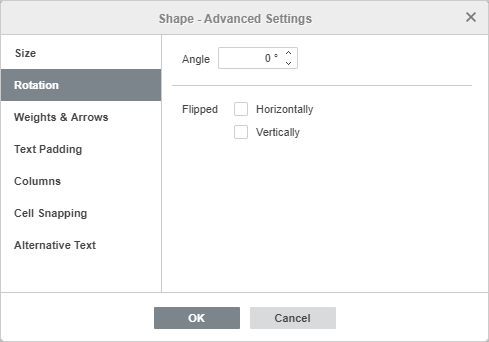
The Rotation tab contains the following parameters:
- Angle - use this option to rotate the shape by an exactly specified angle. Enter the necessary value measured in degrees into the field or adjust it using the arrows on the right.
- Flipped - check the Horizontally box to flip the shape horizontally (left to right) or check the Vertically box to flip the shape vertically (upside down).
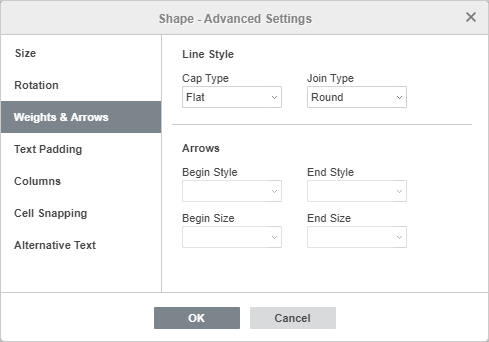
The Weights & Arrows tab contains the following parameters:
- Line Style - this option group allows to specify the following parameters:
- Arrows - this option group is available if a shape from the Lines shape group is selected. It allows to set the arrow Start and End Style and Size by selecting the appropriate option from the dropdown lists.
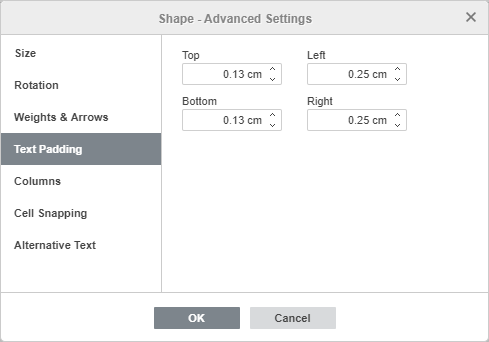
The Text Padding tab allows to change the autoshape Top, Bottom, Left and Right internal margins (i.e. the distance between the text within the shape and the autoshape borders).
Note: this tab is only available if text is added within the autoshape, otherwise the tab is disabled.
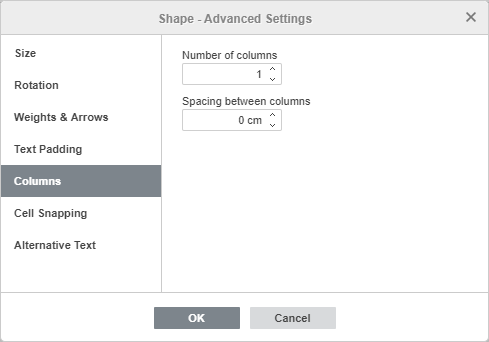
The Columns tab allows to add columns of text within the autoshape specifying the necessary Number of columns (up to 16) and Spacing between columns. Once you click OK, the text that already exists or any other text you enter within the autoshape will appear in columns and will flow from one column to another.
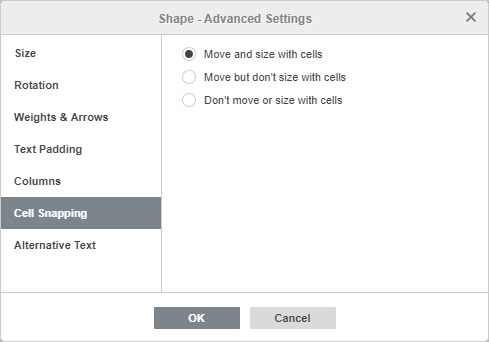
The Cell Snapping tab contains the following parameters:
- Move and size with cells - this option allows to snap the shape to the cell behind it. If the cell moves (e.g. if you insert or delete some rows/columns), the shape will be moved together with the cell. If you increase or decrease the width or height of the cell, the shape will change its size as well.
- Move but don't size with cells - this option allows to snap the shape to the cell behind it preventing the image from being resized. If the cell moves, the shape will be moved together with the cell, but if you change the cell size, the shape dimensions remain unchanged.
- Don't move or size with cells - this option allows to prevent the shape from being moved or resized if the cell position or size was changed.
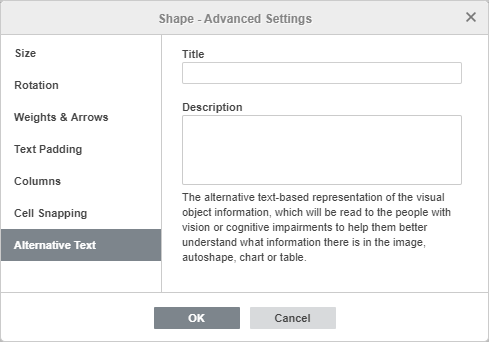
The Alternative Text tab allows to specify a Title and Description which will be read to the people with vision or cognitive impairments to help them better understand what information there is in the shape.
Insert and format text within the autoshape
To insert a text into the autoshape select the shape with the mouse and start typing your text. The text you add in this way becomes a part of the autoshape (when you move or rotate the shape, the text moves or rotates with it).
All the formatting options you can apply to the text within the autoshape are listed here.
Join autoshapes using connectors
You can connect autoshapes using lines with connection points to demonstrate dependencies between the objects (e.g. if you want to create a flowchart). To do that,
- click the Shape icon at the Insert tab of the top toolbar,
- select the Lines group from the menu,

- click the necessary shape within the selected group (excepting the last three shapes which are not connectors, namely Curve, Scribble and Freeform),
- hover the mouse cursor over the first autoshape and click one of the connection points that appear on the shape outline,
- drag the mouse cursor towards the second autoshape and click the necessary connection point on its outline.
If you move the joined autoshapes, the connector remains attached to the shapes and moves together with them.
You can also detach the connector from the shapes and then attach it to any other connection points.
Alla pagina precedente